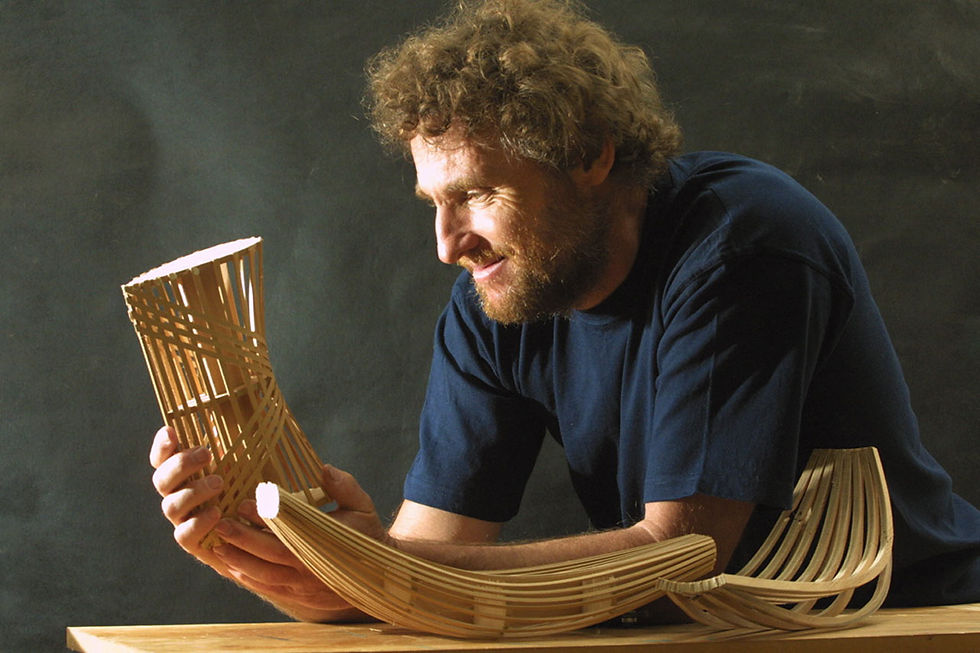Q&A with David Trubridge | Designer
- Admin
- Sep 11, 2017
- 4 min read
Cooper Interiors recently had the honour of sitting down with world renowned lighting and furniture designer David Trubridge. Inspired by mother nature and stories of pacific migration, David's studio based in Hawkes Bay, New Zealand has a truly special approach to design which creates beautiful natural aesthetics. Wherever possible timber is sourced from sustainably managed plantations in New Zealand and the U.S.A.
What inspired you to start your business?
What is start and when? I started making furniture when I left university and for many years I was designing and making on my own and then I started the company 20 odd years ago. There was no real starting point, one thing grew from another. The original calling to make furniture was a lifestyle choice, living in North England and wanting to get out of the city. The crafting came after that as a sort of a way of making a living in that place.
When did you move to New Zealand?
After establishing my business over 10 years making and crafting my own furniture, we wanted to see the world. We sold the house, the business, the workshop and bought a yacht. We headed off on an adventure and ended up in New Zealand five years later.
How would you describe your brand?
I don’t really like that sort of simplification. I generally see the word brand as a facade built from a marketing spin which is put onto show your public face as a construct. We created a brand from the inside out, that’s just our integrity around what I believe in in terms of environmental impact. Making something that is wild and using good products but it’s not a sort of construct that’s put on to sell the product. They’re general expressions of who I am and what we as a company stand for.
How did your time in Antarctica effect the way you work today?
Antarctica really brought out the environmental consciousness in the way we work, although it has always been a large part of who I am. When we renovated our house in Northern England we used second hand slates, made windows out of old ships decking and so on. So, right from the start that’s been part of my ethos. But, Antarctica definitely gave it a boost and put things in focus for me. Talking to scientists there in the early 2000's, they knew all about this (global warming) for years but it hadn’t really gotten out into the world yet. It was the trip of a lifetime.
What differences have you found in New Zealand’s design culture verses England’s?
It’s hard to say because I left England in 1981, what I remember is not what England is now. They are quite similar really. Here obviously we have a strong infusion of Polynesia which is the biggest difference. I think back to some of the London design festivals and design week and there is a lot of “clever design”, design that’s coming out of the left brain, it’s a novelty it’s a gimmick, it’s wit, it’s irony it’s trying to draw attention to itself rather than just being good design. It’s trying to perform tricks, which is understandable as it’s so hard to make a living out of it. I’ve seen a little bit of it here but more so in England so that’s
a big difference.
What do you like most about New Zealand’s design culture and history?
Polynesia has been really important to me since we came here, the whole story of the Polynesian migration fascinates me. This culture was crossing oceans before Britain was crossing rivers in a coracle which is amazing. I think it’s one of the most unsung feats of human culture, to be able to navigate across the Pacific Ocean without any instruments, purely through their connection to the world around them and understanding it. They are moving, the skies are moving, the seasons are changing, the stars are in different places at different times of the year they knew where they needed to be underneath those stars between those islands. It’s that kind of connection to the environment around them and understanding of it that I find the most interesting about this part of the world.
In today's world, what we are realising is that there is a massive resurgence of first nations, indigenous culture asserting themselves, saying we actually are just as important as you, history didn’t begin with the West. You might have written the book but we have our own history which is different and in some places longer back than that. Our culture (British) is a rapacious one. It’s an inquisitive one, it destroys the environment for its own end it won’t last. Those cultures will because they understand the balance, that’s why I like living down here.
What is your favourite experience within your design career?
What I enjoy doing most is more installation and story telling kind of work. The way we do it is to create an installation around a story, which goes onto creating products we still sell today, but the whole thing was a story. The story gave it a reason to be.
What is the best piece of advice you’ve ever been given?
Launch out into the deep.
All imagery is credited to David Trubridge. For context, please click on the image which will redirect you to the source.









Comments